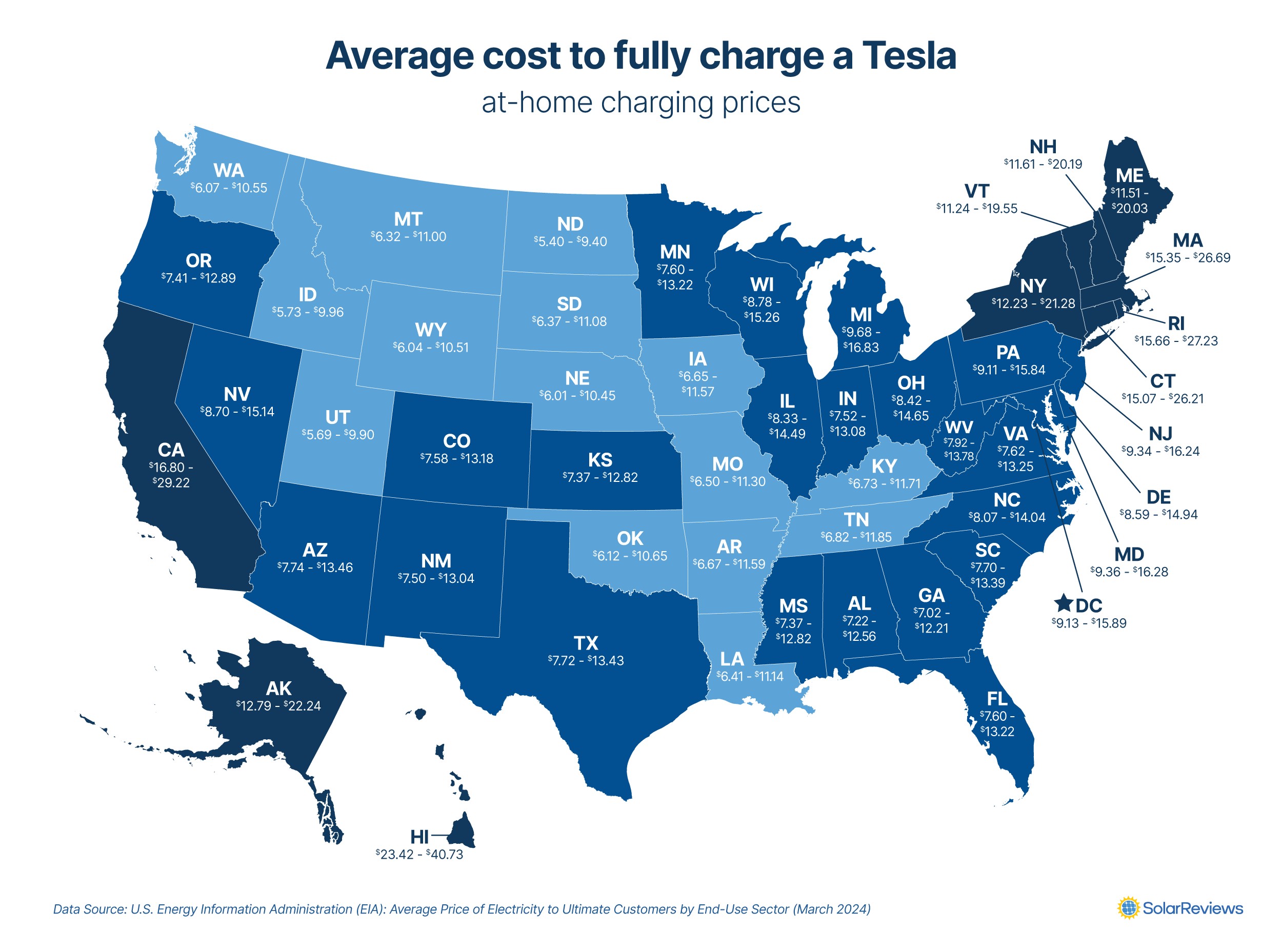Charging an electric vehicle (EV) like a Tesla is often touted as a significant cost-saving compared to fueling a gasoline car. But exactly How Much Does Charging A Tesla Cost in 2025? The answer isn’t always straightforward and depends on several factors, but understanding these can help you budget effectively and maximize your savings.
Generally, you can expect to pay between $10.98 and $18.00 to fully charge a Tesla at home. However, this is just an average. The actual cost fluctuates based on your location, electricity prices, the specific Tesla model you drive, and your charging habits. While public charging offers convenience on the go, it usually comes at a higher price, sometimes even exceeding the cost of gasoline.
For Tesla owners looking to minimize charging expenses, solar power emerges as the most economical option. This article breaks down the costs associated with charging your Tesla in various scenarios – at home, at public charging stations, and using solar energy. We’ll delve into the specifics for each Tesla model to give you a clear picture of what to expect.
Breaking Down Tesla Charging Costs: Home vs. Public vs. Solar
The cost to charge your Tesla varies significantly depending on where and how you charge it. Let’s explore the three primary methods:
Charging Your Tesla at Home: The Most Affordable Regular Option
Home charging is typically the cheapest and most convenient way to keep your Tesla powered up. The cost to fully charge a Tesla at home in 2025 ranges from $10.98 to $18.00. This estimate is based on the average U.S. electricity rate and accounts for charging inefficiencies.
Tesla vehicles come with different battery capacities, influencing both range and charging costs. Battery sizes range from 75 kWh in models like the Model Y to a substantial 123 kWh in the Cybertruck. The table below outlines the estimated home charging cost for each Tesla model:
| Tesla Model | Battery Capacity (kWh) | Estimated Home Charging Cost* |
|---|---|---|
| Tesla Model X | 100 | $14.63 |
| Tesla Model X Plaid | 100 | $14.63 |
| Tesla Model 3 Performance | 82 | $12.00 |
| Tesla Model 3 Long Range AWD | 82 | $12.00 |
| Tesla Model 3 Long Range RWD | 82 | $12.00 |
| Tesla Model S | 100 | $14.63 |
| Tesla Model S Plaid | 100 | $14.63 |
| Tesla Model Y Performance | 75 | $10.98 |
| Tesla Model Y Long Range AWD | 75 | $10.98 |
| Tesla Model Y Long Range RWD | 75 | $10.98 |
| Model Y Launch Series LR AWD | 75 | $10.98 |
| Tesla Cybertruck | 123 | $18.00 |
*Assumes 90% charging efficiency and the average U.S. electricity rate.
It’s important to note that EV chargers aren’t perfectly efficient. You’ll always use slightly more electricity than the battery capacity to achieve a full charge. The 90% efficiency assumed in these calculations is a reasonable average, but actual efficiency can vary based on the charger type and environmental conditions. For optimal cost savings and battery health, Level 2 chargers are recommended for home Tesla charging.
 Map of the United States that shows the average cost of charging a Tesla at home in each state in 2024
Map of the United States that shows the average cost of charging a Tesla at home in each state in 2024
Tesla Supercharger and Public Charging Network Costs
While home charging is ideal for daily use, Tesla’s Supercharger network and other public charging stations are essential for long journeys. However, public charging comes at a premium.
Charging a Tesla at a Supercharger can cost anywhere from $17.81 to upwards of $70 for a full charge. Tesla Supercharger rates range from $0.25 to $0.60 per kWh and vary by location and time of day.
The following table provides estimated Supercharger costs for different Tesla models, before any additional fees:
| Tesla Model | Battery Capacity (kWh) | Estimated Supercharger Cost (Before Fees)* |
|---|---|---|
| Tesla Model X | 100 | $23.75 – $57.00 |
| Tesla Model X Plaid | 100 | $23.75 – $57.00 |
| Tesla Model 3 Performance | 82 | $19.48 – $46.74 |
| Tesla Model 3 Long Range AWD | 82 | $19.48 – $46.74 |
| Tesla Model 3 Long Range RWD | 82 | $19.48 – $46.74 |
| Tesla Model S | 100 | $23.75 – $57.00 |
| Tesla Model S Plaid | 100 | $23.75 – $57.00 |
| Tesla Model Y Performance | 75 | $17.81 – $42.75 |
| Tesla Model Y Long Range AWD | 75 | $17.81 – $42.75 |
| Tesla Model Y Long Range RWD | 75 | $17.81 – $42.75 |
| Model Y Launch Series LR AWD | 75 | $17.81 – $42.75 |
| Tesla Cybertruck | 123 | $29.22 – $70.12 |
*Assumes 95% charging efficiency, excluding potential fees.
Tesla Superchargers are DC fast chargers, delivering a rapid charge ideal for long trips. They can add around 200 miles of range in just 15 minutes. You can locate Superchargers easily using the Tesla app. Prices fluctuate based on location and time, with user reports on platforms like Reddit indicating ranges from $0.25 to $0.60 per kWh recently.
Beyond Superchargers, you can also use third-party charging networks like ChargePoint and EVgo, often requiring an adapter. Keep in mind that public charging stations, including Superchargers, often include extra fees. Tesla Superchargers, for example, may impose idle fees ($1.00/minute) if you leave your car plugged in after charging is complete, and congestion fees ($1.00/minute) at busy locations.
Solar Power: The Cheapest Way to Charge Your Tesla
For Tesla owners committed to maximizing savings and sustainability, solar power is the most cost-effective charging solution. When you charge your Tesla using solar energy generated at your home, the cost of electricity plummets.
The estimated cost of charging an EV with solar power is around $0.06 per kWh. This dramatically reduces charging expenses compared to grid electricity or public charging.
Here’s how the estimated charging costs break down for each Tesla model when using solar power:
| Tesla Model | Battery Capacity (kWh) | Estimated Solar Charging Cost |
|---|---|---|
| Tesla Model X | 100 | $5.40 |
| Tesla Model X Plaid | 100 | $5.40 |
| Tesla Model 3 Performance | 82 | $4.42 |
| Tesla Model 3 Long Range AWD | 82 | $4.42 |
| Tesla Model 3 Long Range RWD | 82 | $4.42 |
| Tesla Model S | 100 | $5.40 |
| Tesla Model S Plaid | 100 | $5.40 |
| Tesla Model Y Performance | 75 | $4.05 |
| Tesla Model Y Long Range AWD | 75 | $4.05 |
| Tesla Model Y Long Range RWD | 75 | $4.05 |
| Model Y Launch Series LR AWD | 75 | $4.05 |
| Tesla Cybertruck | 123 | $6.64 |
While installing solar panels involves an initial investment (around $19,000 on average for a system), the long-term savings can be substantial. Many homeowners see a return on their solar investment in as little as 5 years through reduced energy bills and EV charging costs. Even adding just five solar panels can significantly offset your Tesla charging expenses. If you’re considering solar, inform your installer about your EV charging needs to ensure your system is appropriately sized.
Monthly Tesla Charging Costs and Key Influencing Factors
On average, you can anticipate spending between $39 and $57 per month to charge your Tesla at home. The Cybertruck, with its larger battery, might cost between $65 and $73 per month. This aligns with general averages for EV charging costs.
Several factors influence your actual Tesla charging costs:
- Local Electricity Rates: Electricity prices vary significantly by state and even within the same state depending on your utility provider. States like Hawaii, California, and Massachusetts have higher electricity rates, leading to increased charging costs compared to states with lower rates.
- Location and Climate: Extreme temperatures, particularly cold weather, can reduce battery efficiency, requiring more frequent charging. Terrain and driving conditions also play a role; uphill driving or stop-and-go traffic consumes more energy.
- Tesla Model: As discussed, battery capacity differs across Tesla models, directly impacting charging costs. Models with larger batteries cost more to charge fully but offer longer ranges.
- Driving Habits and Lifestyle: Your daily commute, driving style, and usage of in-car features like air conditioning and seat heaters affect energy consumption and charging frequency. More driving and energy-intensive features mean more charging and higher costs.
 Map of the United States that shows the average cost of charging a Tesla at home in each state in 2024
Map of the United States that shows the average cost of charging a Tesla at home in each state in 2024
Leveraging Time-of-Use (TOU) Rates: If your electricity provider offers TOU rates, you can save money by charging your Tesla during off-peak hours, typically overnight, when electricity is cheaper. Some utilities even offer special EV charging plans.
Tesla vs. Gas Car: A Cost Comparison
Even with fluctuating electricity prices, charging a Tesla is often significantly cheaper than fueling a gasoline car. According to AAA, the average gas price is around $3.08 per gallon.
The average monthly home charging cost for a Tesla is approximately $47.35. In contrast, the U.S. Bureau of Labor Statistics estimates the average monthly gasoline cost to be around $204.
Switching to a Tesla can potentially save you over $150 per month or $1,800 annually in fuel costs alone! These savings can be even more substantial when combined with home solar charging.
FAQs About Tesla Charging Costs
Q: Is it always cheaper to charge at home?
A: Yes, generally charging at home is the cheapest option for regular Tesla charging. Public charging, especially Supercharging, is more expensive but necessary for long trips.
Q: How can I find the cheapest public charging stations?
A: Use apps like the Tesla app, PlugShare, or ChargeHub to compare prices at nearby public charging stations. Consider non-Supercharger options if time is not a constraint, as they may be cheaper.
Q: Will charging my Tesla increase my home electricity bill significantly?
A: Yes, you will see an increase in your electricity bill, but this is usually offset by the savings from not buying gasoline. The exact increase depends on your driving habits and electricity rates.
Q: Is it better to charge my Tesla every night, even if it’s not fully depleted?
A: Yes, it’s generally recommended to keep your Tesla plugged in whenever possible to maintain battery charge and take advantage of off-peak charging rates. Tesla batteries are designed for frequent charging.
Q: Do Tesla charging costs vary by time of day at Superchargers?
A: Yes, Tesla Supercharger pricing can vary by time of day and location. Prices are often higher during peak hours and lower during off-peak hours. Check the Tesla app for real-time pricing information.
By understanding the various factors influencing Tesla charging costs and exploring options like home and solar charging, you can effectively manage your EV expenses and enjoy the financial and environmental benefits of driving electric.

